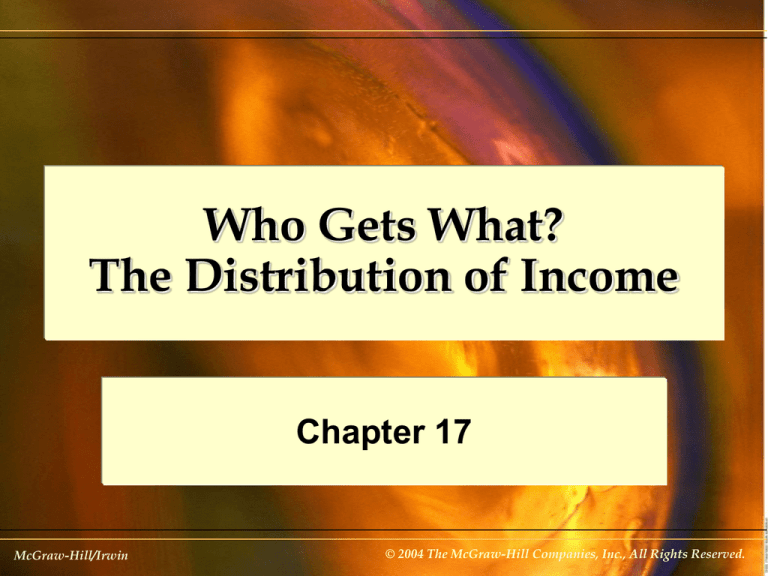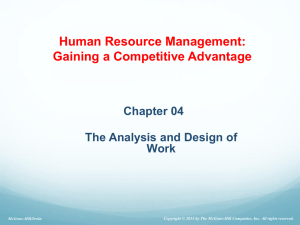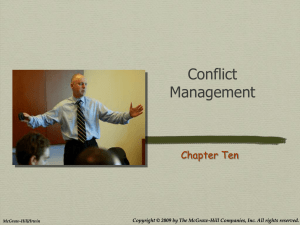
Who Gets What?
The Distribution of Income
Chapter 17
McGraw-Hill/Irwin
© 2004 The McGraw-Hill Companies, Inc., All Rights Reserved.
Laugher Curve
Two economists were walking down the
street when they noticed two women
yelling across the street at each other from
their apartment windows.
McGraw-Hill/Irwin
© 2004 The McGraw-Hill Companies, Inc., All Rights Reserved.
Laugher Curve
“Of course they will never come to an
agreement,” stated the first economist.
“And why is that?” inquired his companion.
“Why, of course, because they are arguing
from different premises.”
McGraw-Hill/Irwin
© 2004 The McGraw-Hill Companies, Inc., All Rights Reserved.
Ways of Considering the
Distribution of Income
Share distribution of income is the name
given to this relative division of total
income among income groups.
McGraw-Hill/Irwin
© 2004 The McGraw-Hill Companies, Inc., All Rights Reserved.
Ways of Considering the
Distribution of Income
Socioeconomic distribution of income is
the allocation of income among relevant
socioeconomic groupings.
McGraw-Hill/Irwin
© 2004 The McGraw-Hill Companies, Inc., All Rights Reserved.
The Share Distribution of
Income
The share distribution of income measures
aggregate family income by quintile.
McGraw-Hill/Irwin
© 2004 The McGraw-Hill Companies, Inc., All Rights Reserved.
The Lorenz Curve
A Lorenz curve is a geometric
representation of the size distribution of
income among families in a given nation at
a given time.
McGraw-Hill/Irwin
© 2004 The McGraw-Hill Companies, Inc., All Rights Reserved.
The Lorenz Curve
The cumulative percentage of families is
on the horizontal axis, arranged from
poorest to richest.
The cumulative percentage of family
income is on the vertical axis.
McGraw-Hill/Irwin
© 2004 The McGraw-Hill Companies, Inc., All Rights Reserved.
The Lorenz Curve
Both axes start at zero and end at 100
percent.
A perfectly equal distribution of income is
represented by a diagonal line.
An unequal distribution of income is
represented by a Lorenz curve that is
below the diagonal line.
McGraw-Hill/Irwin
© 2004 The McGraw-Hill Companies, Inc., All Rights Reserved.
The Lorenz Curve
If income were equally distributed, the
Lorenz Curve would be a diagonal line.
All real-world Lorenz curves are below the
diagonal since income is always
distributed unequally.
McGraw-Hill/Irwin
© 2004 The McGraw-Hill Companies, Inc., All Rights Reserved.
Lorenz Curve of U.S. Income,
2001
C
Lowest fifth
Second fifth
3.5 %
8.8
3.5%
12.3
Third fifth
14.5
26.8
Fourth fifth
23.1
49.9
Highest fifth
40.1
100.0
Cumulative percentage of income
Income
Quintile
Percentage Cumulative
of Total Percentage of
Family
Total Family
Income
Income
100
J
80
60
I
B
40
H
20
A
G
F
0
20
40
60
80
100
Cumulative percentage of families
McGraw-Hill/Irwin
© 2004 The McGraw-Hill Companies, Inc., All Rights Reserved.
U.S. Income Distribution Over
Time
From 1929 to 1970, income inequality in
the U.S. decreased.
From 1970 to 2001, it increased.
McGraw-Hill/Irwin
© 2004 The McGraw-Hill Companies, Inc., All Rights Reserved.
U.S. Income Distribution Over
Time
Up to 1970, equality increased because:
Welfare programs.
Unemployment insurance.
Social security.
Progressive taxation.
Improved macroeconomic performance of the
economy.
McGraw-Hill/Irwin
© 2004 The McGraw-Hill Companies, Inc., All Rights Reserved.
U.S. Income Distribution Over
Time
Inequality increased because:
Wage increases have not kept up with price
increases.
A movement away from progressive taxation.
A reduction in government funding for some
social programs.
McGraw-Hill/Irwin
© 2004 The McGraw-Hill Companies, Inc., All Rights Reserved.
Lorenz Curve for the U.S. 1929,
1970, 2001
Cumulative percentage of
income
100%
80
60
40
Line of absolute
equality
1970
2001
1929
20
0
40
20
60
80 100%
Cumulative percentage of population
McGraw-Hill/Irwin
© 2004 The McGraw-Hill Companies, Inc., All Rights Reserved.
Defining Poverty
It is difficult to say where poverty begins.
The official definition of poverty is a
combination of a relative and an absolute
measure
McGraw-Hill/Irwin
© 2004 The McGraw-Hill Companies, Inc., All Rights Reserved.
The Official Definition of
Poverty
The poverty threshold is the income
below which a family is considered to live
in poverty.
McGraw-Hill/Irwin
© 2004 The McGraw-Hill Companies, Inc., All Rights Reserved.
The Official Definition of
Poverty
The U.S. government definition of poverty
is:
Equal to or less than three times an average
family’s USDA-calculated minimum food
expenditures.
McGraw-Hill/Irwin
© 2004 The McGraw-Hill Companies, Inc., All Rights Reserved.
The Official Definition of
Poverty
The number of people in poverty:
Decreased during the 1960s.
Increased during the 1970s through early
1990s.
Decreased during the mid- through late 1990s.
Increased in the early 2000s.
McGraw-Hill/Irwin
© 2004 The McGraw-Hill Companies, Inc., All Rights Reserved.
Debates about the Definition
of Poverty
The food budget used to determine the
poverty line was established in the 1960s.
It is not recalculated to account for rising
standards of living.
McGraw-Hill/Irwin
© 2004 The McGraw-Hill Companies, Inc., All Rights Reserved.
The Definition of Poverty Is
Too Low
Food prices are adjusted for inflation
meaning the definition includes significant
aspects of relativity.
McGraw-Hill/Irwin
© 2004 The McGraw-Hill Companies, Inc., All Rights Reserved.
The Definition of Poverty Is
Too Low
Those favoring a relative measure of
poverty want to multiply the food figure by
roughly four rather than three.
McGraw-Hill/Irwin
© 2004 The McGraw-Hill Companies, Inc., All Rights Reserved.
The Definition of Poverty Is
Too High
Those favoring an absolute measure of
poverty argue that the current measure is
too high.
Poverty figures do not include noncash
assistance or the value of assets or savings
recipients may have.
McGraw-Hill/Irwin
© 2004 The McGraw-Hill Companies, Inc., All Rights Reserved.
The Cost of Poverty
Some feel that society suffers when some
of its people are in poverty.
When poverty decreases, the incentives for
crime also decreases.
McGraw-Hill/Irwin
© 2004 The McGraw-Hill Companies, Inc., All Rights Reserved.
The Cost of Poverty
Some people argue that poverty increased
as a result of government tax and spending
policies.
Others argue that it is the result of
demographic changes.
McGraw-Hill/Irwin
© 2004 The McGraw-Hill Companies, Inc., All Rights Reserved.
International Dimensions of
Income Inequality
Another way of judging income inequality
is to compare conditions in one country
with those of another.
One could also look at the total level of
world income.
McGraw-Hill/Irwin
© 2004 The McGraw-Hill Companies, Inc., All Rights Reserved.
Comparing Income
Distribution With Other
Countries
The U.S. has less income inequality than
most developing nations, but more income
inequality than many developed nations.
McGraw-Hill/Irwin
© 2004 The McGraw-Hill Companies, Inc., All Rights Reserved.
Cumulative percentage of income
U.S. Income Distribution
Compared to Other Countries
McGraw-Hill/Irwin
100
80
60
40
Sweden
Japan
20
0
United States
Brazil
20
40
60
80 100
Cumulative percentage of population
© 2004 The McGraw-Hill Companies, Inc., All Rights Reserved.
Income Distribution Among
Countries
Income is highly unequally distributed
among countries.
A Lorenz curve for world income would
show much more inequality than the
Lorenz curve for a particular country.
McGraw-Hill/Irwin
© 2004 The McGraw-Hill Companies, Inc., All Rights Reserved.
The Total Amount of Income in
Various Countries
Is the absolute level of income as
important as the distribution of income?
Which is it better?
Earning
$3,000 per year in Bangladesh, which puts
you in the top 10 percent of that nation’s income
distribution?
Earning four times as much in the U.S., which
places you in the bottom 10 percent in the U.S.?
McGraw-Hill/Irwin
© 2004 The McGraw-Hill Companies, Inc., All Rights Reserved.
Per Capita Income (GDP) in
Various Countries in 2001
$40,000
35,000
30,000
25,000
20,000
15,000
10,000
5,000
0
United
States
McGraw-Hill/Irwin
Japan
United Sweden New Taiwan
Kingdom
Zealand
Brazil
Bang- Kenya Congo,
Dem.
ladesh
Rep.
© 2004 The McGraw-Hill Companies, Inc., All Rights Reserved.
The Distribution of Wealth
Wealth and income are often used In
considering equality.
Wealth is the value of the things individuals
own.
Income is payments received plus or minus
changes in value in one’s assets in a specified
time period.
McGraw-Hill/Irwin
© 2004 The McGraw-Hill Companies, Inc., All Rights Reserved.
A Lorenz Curve of the
Distribution of Wealth
Wealth is more unequally distributed in the
U.S. than is income.
The bottom 40 percent of U.S. population
has zero net worth.
McGraw-Hill/Irwin
© 2004 The McGraw-Hill Companies, Inc., All Rights Reserved.
Wealth Percentage of
Quintile total household
wealth
Bottom fifth
Second fifth
Third fifth
Fourth fifth
Top fifth
– 0.2
0.2
2.7
13.2
84.1
Cumulative percentage of wealth/income
Wealth Compared to Income
in the U.S.
100
80
60
40
Family
income
20
0
Household
wealth
20
40
60
80
100
Cumulative percentage of families/households
McGraw-Hill/Irwin
© 2004 The McGraw-Hill Companies, Inc., All Rights Reserved.
How Much Wealth Do the
Wealthy Have?
A million dollars is no longer what it used
to be.
To be in the top 5 percent of the wealthy
would require holdings of $4 million.
McGraw-Hill/Irwin
© 2004 The McGraw-Hill Companies, Inc., All Rights Reserved.
Socioeconomic Dimensions of
Income Inequality
Income distribution can be shown
according to socioeconomic characteristics:
Race.
Ethnicity.
Geographic region.
Gender.
Type of job.
McGraw-Hill/Irwin
© 2004 The McGraw-Hill Companies, Inc., All Rights Reserved.
Income Distribution According
to Socioeconomic
Characteristics
There seems to be a professionalnonprofessional class distinction rising in
the U.S.
Substantial differences also exist between
the incomes of women and men and
among races.
McGraw-Hill/Irwin
© 2004 The McGraw-Hill Companies, Inc., All Rights Reserved.
Income Distribution According
to Class
The U.S. has socioeconomic classes with
some mobility among classes.
Class divisions are currently not
determined solely by income source.
McGraw-Hill/Irwin
© 2004 The McGraw-Hill Companies, Inc., All Rights Reserved.
The Importance of the Middle
Class
Class structure in developing countries
looks like a pyramid, with the upper class
on top.
In developed nations, class structure looks
more like a diamond, with the middle class
– the largest class – in the middle.
McGraw-Hill/Irwin
© 2004 The McGraw-Hill Companies, Inc., All Rights Reserved.
The Class System as a Pyramid
and as a Diamond
Developing Country’s
Class System
Upper
class
Upper
class
Middle
class
Middle
class
Lower
class
McGraw-Hill/Irwin
U.S. Class System
Lower
class
© 2004 The McGraw-Hill Companies, Inc., All Rights Reserved.
Distributional Questions and
Tensions in Society
Both radicals and conservatives describe
the tensions among classes in society
better than the mainstream, classless
analysis.
McGraw-Hill/Irwin
© 2004 The McGraw-Hill Companies, Inc., All Rights Reserved.
Distributional Questions and
Tensions in Society
Mainstream economists tend to focus on
the size distribution of income.
Radical economists focus on class and
group structures in their analysis.
McGraw-Hill/Irwin
© 2004 The McGraw-Hill Companies, Inc., All Rights Reserved.
Distributional Questions and
Tensions in Society
Conservative economists emphasize the
role of special interests in shaping
government policy.
McGraw-Hill/Irwin
© 2004 The McGraw-Hill Companies, Inc., All Rights Reserved.
Distributional Questions and
Tensions in Society
Americans recognize that there are class,
gender, and racial differences in income
and wealth.
Rather than seeking radical solutions, they
work for change within the present system.
McGraw-Hill/Irwin
© 2004 The McGraw-Hill Companies, Inc., All Rights Reserved.
Income Distribution and
Fairness
Whether the distribution of income is fair or
should be changed involves a value
judgment.
McGraw-Hill/Irwin
© 2004 The McGraw-Hill Companies, Inc., All Rights Reserved.
Philosophical Debates about
Equality and Fairness
Some philosophers argue that inequality
creates diversity in our lives, and that
diversity enriches the lives of everyone.
McGraw-Hill/Irwin
© 2004 The McGraw-Hill Companies, Inc., All Rights Reserved.
Philosophical Debates about
Equality and Fairness
The Declaration of Independence asserts
that “all men are created equal.”
Believing in equality does not necessarily
mean that income should be equally
distributed.
McGraw-Hill/Irwin
© 2004 The McGraw-Hill Companies, Inc., All Rights Reserved.
Philosophical Debates about
Equality and Fairness
In their objective role, economists limit
themselves to explaining the effect of
various policies on the distribution of
income.
McGraw-Hill/Irwin
© 2004 The McGraw-Hill Companies, Inc., All Rights Reserved.
Philosophical Debates about
Equality and Fairness
Value judgments must be made when
judging economic policies.
McGraw-Hill/Irwin
© 2004 The McGraw-Hill Companies, Inc., All Rights Reserved.
Fairness and Equality
Fairness is not the same as equality.
Fairness has many dimensions and it is
often difficult to say what is fair and what is
not fair.
McGraw-Hill/Irwin
© 2004 The McGraw-Hill Companies, Inc., All Rights Reserved.
Fairness and Equality
There are three problems in determining
whether an equal income distribution is
fair.
People do not start from equivalent positions.
People’s needs differ.
People’s efforts differ.
McGraw-Hill/Irwin
© 2004 The McGraw-Hill Companies, Inc., All Rights Reserved.
Fairness as Equality of
Opportunity
Most Americans see fairness as equality of
opportunity.
There are great differences of opinion as to
what constitutes “equal opportunity.”
McGraw-Hill/Irwin
© 2004 The McGraw-Hill Companies, Inc., All Rights Reserved.
The Problems of Redistributing
Income
Society may decide to redistribute income
from the rich to the poor to meet its ideal of
fairness.
Redistribution programs can have
substantial side effects which can subvert
the intention of the program.
McGraw-Hill/Irwin
© 2004 The McGraw-Hill Companies, Inc., All Rights Reserved.
Important Side Effects of
Redistributive Programs
There are three side effects of
redistribution of income:
The labor to leisure incentive effect.
The tax avoidance or evasion incentive effect.
The incentive to look more needy than you
really are.
McGraw-Hill/Irwin
© 2004 The McGraw-Hill Companies, Inc., All Rights Reserved.
Politics, Income Redistribution,
and Fairness
Often politics, not value judgments plays a
central role in determining what taxes an
individual will pay.
McGraw-Hill/Irwin
© 2004 The McGraw-Hill Companies, Inc., All Rights Reserved.
Politics, Income Redistribution,
and Fairness
Although the poor outnumber the rich,
there is limited political support for income
redistribution programs:
Many poor do not bother to vote.
Politicians do not see the poor as a solid
voting block.
Poor people who vote often cast their votes
with other issues in mind.
McGraw-Hill/Irwin
© 2004 The McGraw-Hill Companies, Inc., All Rights Reserved.
Income Redistribution Policies
The government redistributes income
through direct and indirect methods.
McGraw-Hill/Irwin
© 2004 The McGraw-Hill Companies, Inc., All Rights Reserved.
Income Redistribution Policies
The direct methods include:
Taxation—policies that tax the rich more than
the poor.
Expenditures—programs that help the poor
more than the rich.
McGraw-Hill/Irwin
© 2004 The McGraw-Hill Companies, Inc., All Rights Reserved.
Income Redistribution Policies
The indirect method involves the
establishment and protection of property
rights.
McGraw-Hill/Irwin
© 2004 The McGraw-Hill Companies, Inc., All Rights Reserved.
Taxation to Redistribute
Income
The federal government gets most of its
taxes from the personal income tax, the
corporate income tax, and the Social
Security tax.
McGraw-Hill/Irwin
© 2004 The McGraw-Hill Companies, Inc., All Rights Reserved.
Taxation to Redistribute
Income
State and local governments get most of
their taxes from income taxes, sales taxes,
and property taxes.
McGraw-Hill/Irwin
© 2004 The McGraw-Hill Companies, Inc., All Rights Reserved.
Taxation to Redistribute
Income
Taxes can be:
Progressive – the average tax rate increases
with income.
Proportional – the average rate of tax is
constant regardless of income.
Regressive – the average tax rate decreases
with income.
McGraw-Hill/Irwin
© 2004 The McGraw-Hill Companies, Inc., All Rights Reserved.
Federal Income Taxes
The personal income tax was more
progressive in the 1940s than it is today.
The top tax was 90 percent in the early 1940s.
It is almost 40 percent today.
McGraw-Hill/Irwin
© 2004 The McGraw-Hill Companies, Inc., All Rights Reserved.
Federal Income Taxes
The Social Security tax is initially
proportional up to a limit of about $85,000,
then it becomes regressive.
McGraw-Hill/Irwin
© 2004 The McGraw-Hill Companies, Inc., All Rights Reserved.
State and Local Taxes
State and local governments get most of
their income from:
Income taxes – which are somewhat
progressive.
Sales taxes – which tend to be proportional but
are slightly regressive.
Property taxes – which are roughly
proportional.
McGraw-Hill/Irwin
© 2004 The McGraw-Hill Companies, Inc., All Rights Reserved.
Taxation to Redistribute
Income
Taxation has not proven to be an effective
means of redistribution income.
McGraw-Hill/Irwin
© 2004 The McGraw-Hill Companies, Inc., All Rights Reserved.
Expenditure Program to
Redistribute Income
Expenditure programs have been more
successful than taxation for redistributing
income.
McGraw-Hill/Irwin
© 2004 The McGraw-Hill Companies, Inc., All Rights Reserved.
Social Security
Social Security – a social insurance
program that provides financial benefits to
the elderly and disabled and to their
eligible dependents and/or survivors.
Medicare – a multibillion-dollar medical
insurance program.
McGraw-Hill/Irwin
© 2004 The McGraw-Hill Companies, Inc., All Rights Reserved.
Public Assistance Programs
Public assistance programs – meanstested social programs targeted to the poor
and providing financial, nutritional, medical,
and housing assistance.
McGraw-Hill/Irwin
© 2004 The McGraw-Hill Companies, Inc., All Rights Reserved.
Public Assistance Programs
The main types of public assistance
programs are:
Temporary Assistance for Needy Families
(TANF).
Food stamps.
Medicaid.
General assistance.
McGraw-Hill/Irwin
© 2004 The McGraw-Hill Companies, Inc., All Rights Reserved.
Supplemental Security Income
Supplemental Security Income (SSI) – a
federal program that pays benefits, based
on need, to the elderly, blind, and disabled.
McGraw-Hill/Irwin
© 2004 The McGraw-Hill Companies, Inc., All Rights Reserved.
Unemployment Compensation
Unemployment compensation – shortterm financial assistance, regardless of
need, to eligible individuals who are
temporarily out of work.
McGraw-Hill/Irwin
© 2004 The McGraw-Hill Companies, Inc., All Rights Reserved.
Housing Programs
Housing programs – federal and state
governments have many different
programs to improve housing or to provide
affordable housing.
McGraw-Hill/Irwin
© 2004 The McGraw-Hill Companies, Inc., All Rights Reserved.
The Success of Income
Redistribution Programs
After-transfer income is significantly closer
to being equally distributed.
The increase in equality comes at the cost
of a reduction in the total amount of income
earned by society.
McGraw-Hill/Irwin
© 2004 The McGraw-Hill Companies, Inc., All Rights Reserved.
The Success of Income
Redistribution Programs
The most important redistribution decisions
the government makes involve the
establishment and protection of property
rights.
McGraw-Hill/Irwin
© 2004 The McGraw-Hill Companies, Inc., All Rights Reserved.
Cumulative percentage of income
Distribution of Income Before &
After Taxes & Transfers, 1998
100
90
80
70
60
50
40
30
20
10
0
McGraw-Hill/Irwin
After taxes
and transfers
Before taxes
and transfers
10 20 30 40 50 60 70 80 90 100
Cumulative percentage of households
© 2004 The McGraw-Hill Companies, Inc., All Rights Reserved.
Who Gets What?
The Distribution of Income
End of Chapter 17
McGraw-Hill/Irwin
© 2004 The McGraw-Hill Companies, Inc., All Rights Reserved.









